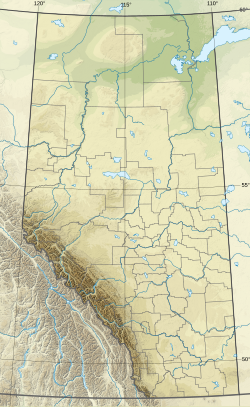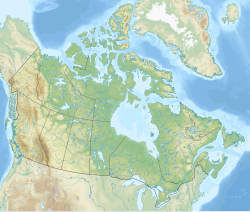Harvie Heights
Harvie Heights | |
|---|---|
| Coordinates: 51°7′31″N 115°23′6″W / 51.12528°N 115.38500°W | |
| Country | Canada |
| Province | Alberta |
| Region | Alberta's Rockies |
| Census division | 15 |
| Municipal district | Municipal District of Bighorn No. 8 |
| Government | |
| • Type | Unincorporated |
| • Governing body | Municipal District of Bighorn No. 8 Council |
| Area (2021)[1] | |
| • Land | 0.62 km2 (0.24 sq mi) |
| Population (2021)[1] | |
| • Total | 163 |
| • Density | 261.6/km2 (678/sq mi) |
| Time zone | UTC−07:00 (MST) |
| • Summer (DST) | UTC−06:00 (MDT) |
| Area code(s) | 403, 587, 825 |
Harvie Heights is a hamlet in Alberta, Canada, within the Municipal District of Bighorn No. 8.[2] It is located within Alberta's Rockies on the Trans-Canada Highway (Highway 1) approximately 4 kilometres (2.5 mi) northwest of Canmore and immediately east of the park gate for Banff National Park.
Demographics
[edit]In the 2021 Census of Population conducted by Statistics Canada, Harvie Heights had a population of 163 living in 81 of its 152 total private dwellings, a change of -11.4% from its 2016 population of 184. With a land area of 0.62 km2 (0.24 sq mi), it had a population density of 262.9/km2 (680.9/sq mi) in 2021.[1]
As a designated place in the 2016 Census of Population conducted by Statistics Canada, Harvie Heights had a population of 184 living in 76 of its 113 total private dwellings, a change of 5.1% from its 2011 population of 175. With a land area of 0.62 km2 (0.24 sq mi), it had a population density of 296.8/km2 (768.6/sq mi) in 2016.[13]
See also
[edit]References
[edit]- ^ a b c d "Population and dwelling counts: Canada and designated places". Statistics Canada. February 9, 2022. Retrieved February 10, 2022.
- ^ "Specialized and Rural Municipalities and Their Communities" (PDF). Alberta Municipal Affairs. June 3, 2024. Retrieved June 14, 2024.
- ^ "Population of unincorporated places of 50 persons and over, Alberta, 1961 and 1956". 1961 Census of Canada: Population (PDF). Series SP: Unincorporated Villages. Vol. Bulletin SP—4. Ottawa: Dominion Bureau of Statistics. April 18, 1963. Retrieved November 29, 2021.
- ^ "Population of unincorporated places of 50 persons and over, 1966 and 1961 (Alberta)". Census of Canada 1966: Population (PDF). Special Bulletin: Unincorporated Places. Vol. Bulletin S–3. Ottawa: Dominion Bureau of Statistics. August 1968. Retrieved November 29, 2021.
- ^ "Population of Unincorporated Places of 50 persons and over, 1971 and 1966 (Alberta)". 1971 Census of Canada: Population (PDF). Special Bulletin: Unincorporated Settlements. Vol. Bulletin SP—1. Ottawa: Statistics Canada. March 1973. Retrieved November 29, 2021.
- ^ "Geographical Identification and Population for Unincorporated Places of 25 persons and over, 1971 and 1976". 1976 Census of Canada (PDF). Supplementary Bulletins: Geographic and Demographic (Population of Unincorporated Places—Canada). Vol. Bulletin 8SG.1. Ottawa: Statistics Canada. May 1978. Retrieved November 29, 2021.
- ^ 1981 Census of Canada (PDF). Place name reference list. Vol. Western provinces and the Territories. Ottawa: Statistics Canada. May 1983. Retrieved November 29, 2021.
- ^ Census Canada 1986: Population (PDF). Alberta: Population and Dwelling Counts – Provinces and Territories. Statistics Canada. June 1977. pp. 12–1 to 12–2. Retrieved November 29, 2021.
- ^ "Table 16: Population and Dwelling Counts, for Urban Areas, 1991 and 1996 Censuses – 100% Data". 96 Canada (PDF). A National Overview: Population and Dwelling Counts. Ottawa: Statistics Canada. April 1997. p. 184–198. Retrieved November 29, 2021.
- ^ "Population and Dwelling Counts, for Canada, Provinces and Territories, and Census Divisions, 2001 and 1996 Censuses - 100% Data (Alberta)". Statistics Canada. August 15, 2012. Retrieved November 29, 2021.
- ^ "Population and dwelling counts, for Canada, provinces and territories, and designated places, 2006 and 2001 censuses - 100% data (Alberta)". Statistics Canada. July 20, 2021. Retrieved November 29, 2021.
- ^ "Population and dwelling counts, for Canada, provinces and territories, and designated places, 2011 and 2006 censuses (Alberta)". Statistics Canada. July 25, 2021. Retrieved August 9, 2024.
- ^ a b "Population and dwelling counts, for Canada, provinces and territories, and designated places, 2016 and 2011 censuses – 100% data (Alberta)". Statistics Canada. February 8, 2017. Retrieved February 13, 2017.


